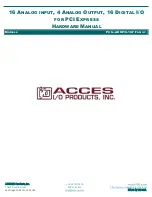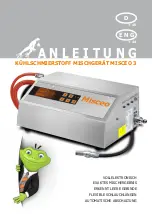
ACCES I/O Products, Inc.
MADE IN THE USA
PCIe-ADIO16-16F Family Manual
5
Rev B1
SINGLE AND SCAN START MODES
Each ADC Start Event can be configured to start either a Scan of channels or a single channel conversion.
Single Start Mode: Writing to +38 with b
it 18 clear (to 0) selects “Single Start Mode”.
Each ADC Start Event, regardless of source, will acquire one channel. No subsequent conversions
will occur until the next ADC Start Event.
Scan Start Mode: Writing to +38 with bit 18 set (to 1) selects “Scan Start Mode”.
Each ADC Start Event will acquire the full configured sequence of channels, starting with CH0 and
proceeding through INx2:0, then no further data will be acquired until a subsequent ADC Start Event.
The channels within this “scan” of data
are acquired at the rate selected via +14. Bit
18 is ignored (assumed zero) if non-Sequenced mode is set (SEQ1:0=00) or if INx2:0==0.
Software Pro Tips:
•
Use our API. Avoid accessing the card registers unless you really know you need to. Contact us
for any questions, we’re here to help.
•
Always use Advanced Sequencer Mode.
•
Always prefer Scan Start Mode unless you have unusual timing needs.
•
Set the periodic rate at +10, set the inside-scan channel rate at +14, configure External Trigger if you are using it, configure the per-channel gains at +18 and +1C, then write to
+3C then +38 to Start or Arm (in Software or ADC Trigger modes, respectively) the Periodic Scans.
Register Overview
Register
Offset [hex]
Read
/Write
Register Name
Register Description
Note: All registers 4-68 must be accessed as 32-bits. Only +0 and +1 are 8-bits
+0 RW
Resets and Power
Board and Feature Reset command bits and ADC Power-Down control bit and status
+4 W
DAC Control
DAC (LTC2664) Command Register bits
+8 R
DAC 4-20mA mode
Indicates which DACs, if any, have current-output circuit installed
+C R
ADC Base Clock
Frequency of the ADC Sequencer Base Clock (Hz) used to calculate the ADC Rate Divisor for desired conversion rates
+10 W/R
ADC Rate Divisor
ADC Start Rate = ADC Base Clock / ADC Rate Divisor (this register)
+14 W/R
ADC Rate Divisor #2
Controls rate of channels inside each scan when running in scan-start mode
+18 W/R
ADC #0 ADV Sequence Gain Each nybble controls the gain code (input range) of the respective ADC channel (0-7)
+1C W/R
ADC #1 ADV Sequence Gain Each nybble controls the gain code (input range) of the respective ADC channel (8-15)
+20 W/R
ADC FAF Threshold
ADC FIFO Almost Full Threshold, can be enabled to generate IRQs when the threshold amount of ADC data is available in the FIFO
+28 R
ADC FIFO Count
ADC FIFO Depth: read to determine how much data is available in the FIFO
+30 R
ADC FIFO Data
ADC FIFO
+38 W/R
ADC #0 Control
ADAS3022 #0 and ADC Control bits
+3C W/R
ADC #1 Control
ADAS3022 #1
+40 W/R
IRQ Enable / Status
IRQ Latch Clear bits and IRQ Enable Control bits / IRQ Latch Status and IRQ Enable Status
+44 W/R
DIO Data
16-bits of DIO Data
+48 W/R
DIO Control
Digital Secondary Function enable bits and direction control for each I/O Group
+68 R
Revision
FPGA code revision
All these registers can be operated from any operating system using any programming language, using either no driver at all (kernel mode, Linux ioperm(3), DOS, etc.) or using one of the
ACCES provided drivers (AIOWDM [for Windows], APCI [for Linux & OSX]), or using any 3
rd
party APIs such as provided with Real-Time OSes. Addresses not explicitly documented are
reserved and should not be accessed.































